How Trees Grow in the Urban Environment 1
Background
What happens to a birdhouse if you hang it on a tree and come back in two years? Will it be at the same height or out of your reach because the tree has grown? (Figure 1).
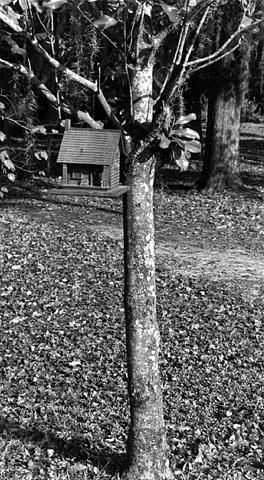
By the end of this article you will be able to answer this question and others about how trees grow.
This publication is for those who love to plant and grow trees. Of course, trees grow the same way in the city as they do in the country (physiologically speaking), but the differing environmental conditions between urban and country environments can affect tree growth differently. Here we highlight those factors in the urban environments that affect tree growth.
What is tree growth?
To set the stage for our discussion of tree growth we must review some terminology.
Trees have six organs. These are leaves, stems and roots (known as vegetative structures), and flowers, fruits, and seeds (known as reproductive structures). This article focuses on vegetative growth—that is the growth of leaves, stems, and roots. Tree growth is the increase in size and numbers of leaves, stems, and roots.
What kinds of trees will we be talking about?
Trees are seed plants—that is they reproduce by seed. They are classified into gymnosperms and angiosperms. Gymnosperms are trees with seeds that develop on the surface or tip of an appendage such as a cone. Examples are cypress and pines. Angiosperms are trees with seeds borne within structures such as fruits (the seed is enclosed). Examples are oaks, elms, maples, and palms. We are going to be describing growth of both gymnosperms and angiosperms. Also, since we live in Florida, there's one more division that is necessary and that is among angiosperms. Palms are angiosperms—but they are different than oaks, maples, and elms, because palms are monocots and are related to grasses. Monocots have a single leaf when they emerge from a seed as a seedling, whereas dicots have two. Oaks, maples, and elms are dicots. So we will first talk about growth of gymnosperms and dicots; then because they grow very differently, we will have a special section on palms.
What controls growth?
Tree growth is a response to the environment and is dependent on its genetic make-up (Figure 2).
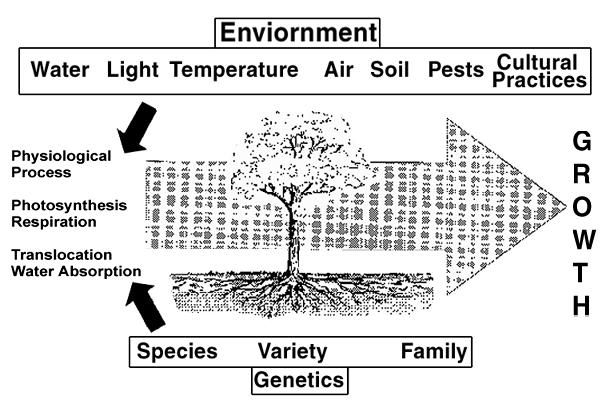
The environment is made up of such factors as water, light, temperature, air, pests, and cultural practices. These all impact physiological processes such as photosynthesis, and the final response is that the tree grows vigorously or slowly. A tree's genetic make-up also influences the way a tree grows. Genetics means what species the tree is, where is its seed source (did it come from northern or southern Florida), and the genetic contribution from its parents. These genetic characteristics, along with its environment, determine how a tree grows. For example, the longleaf pine in Figure 3 is growing quite well. Its genetic make-up and its environment are obviously compatible and favorable to growth. Yet, Figure 4 shows another longleaf pine that is not doing so well. Is this due to its environment—shade, water, fertilizers, etc., or due to its genetics? It's difficult to separate out effects of environment and genetics, but we can definitely conclude that one or the other or both are impacting growth of these two trees. We will talk more about the environment and genetics at the end of the publication in the section, "Some examples of the urban environment influencing growth."
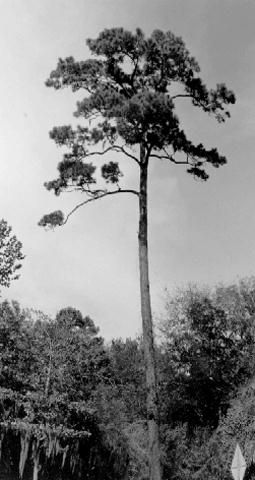
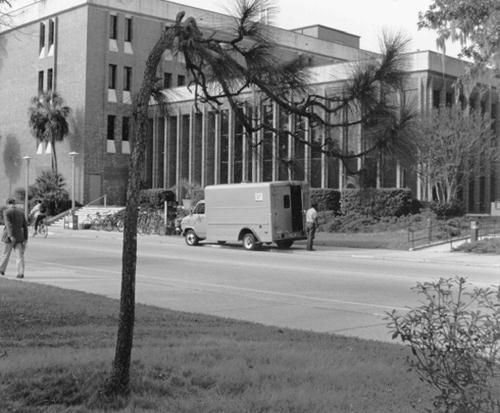
Where does growth occur?
Growth occurs in meristems. A meristem is a tissue that contains cells which have the capacity to divide to make new cells. In general, during growth cells divide, cells elongate, and cells differentiate into structures such as roots and shoots (Figure 5).
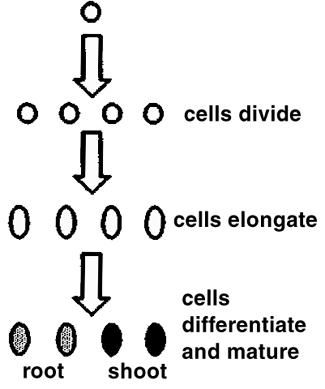
Meristems can also produce new meristems—these are called primordia. For example, an apical meristem in a bud produces new meristems called leaf primordia—each single primordium will grow into a new leaf. Root primordia grow into new roots.
Growth Above Ground
Tree growth above ground includes shoot elongation (height growth), leaf growth, and diameter growth.
Shoot Elongation
Shoots elongate or grow in height at the tips of the branches (Figure 6). Apical meristems are located in the terminal buds at the tips of the branches. What happens is—cells at the apical meristem divide, elongate and differentiate. The steps that we can see are (1) The bud at the tip of the branch opens, (2) leaves emerge and enlarge, and (3) the area between the leaves expands (i.e., the stem grows). Lateral (side) buds grow in the same way but often these are dormant and do not grow until they are released after such activities as pruning.
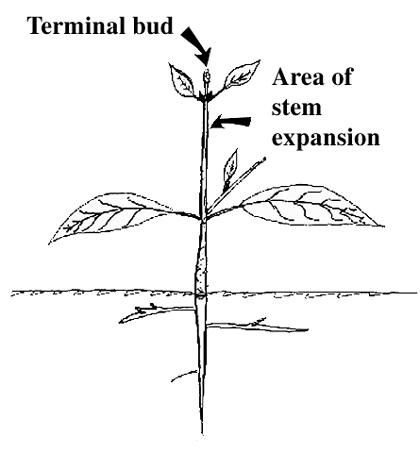
Leaf Growth
On the surface of the apical meristem in the bud, a new meristem is formed. This new meristem is called a leaf primordium, and this is where cells divide and grow to form a leaf. Several meristems on a leaf influence leaf shape (Figure 7).
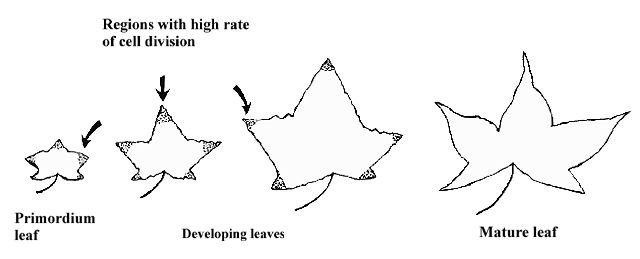
Soon after leaves develop, a new bud primordium (meristem) is formed at the base of each leaf stem. Once formed, this axillary bud has the capacity to become a branch, but may lie dormant for many years.
Diameter Growth
Between the wood and bark is a thin layer of dividing cells called the vascular cambium. This vascular cambium is a meristem that is only a few cells thick. This meristem divides, creating wood on the inside and bark on the outside (Figure 8).
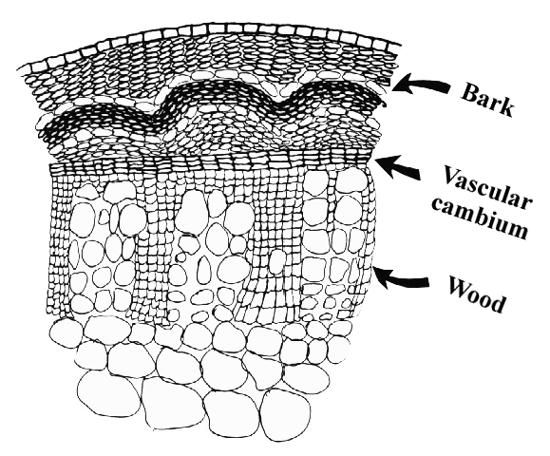
Layer by layer these new cells increase the diameter of the trunk and branches. The wood cells are called "xylem," which means wood in Greek; they carry water and minerals up from the roots. The bark cells are called "phloem," meaning bark in Greek. These cells carry sugars and other materials produced by the plant.
Annual Rings
New layers of wood are added each year between the bark and the previous year's wood. These are called growth or annual rings and may be used to age a tree.
In most parts of Florida, annual rings vary in size and thickness according to the season that they are formed (Figure 9).
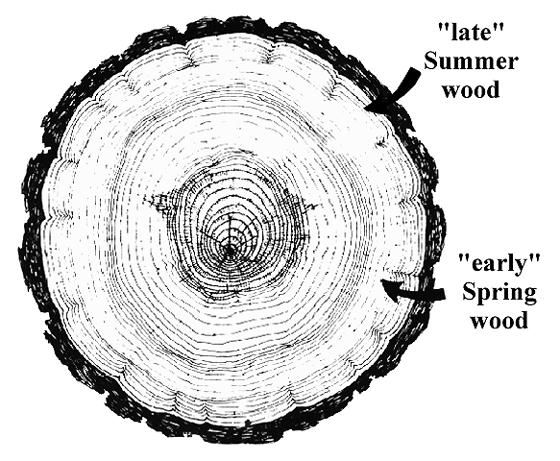
Cells that are produced in the spring are larger with thinner cell walls. These are the light-colored rings, and the wood is called "early" or "spring" wood. Cells produced in the summer are smaller, and this "late" or "summer" wood has a higher density and darker color. It is important to note that not all tree species form annual rings. In fact, some trees that grow all year may not have rings at all. Aging trees in this instance can be challenging.
Bark
All woody trees have bark that protects the tree from pest attacks and environmental impacts such as fire and mechanical injury. Some trees have thick bark that is resistant to injury. Others are easily injured because they have thin bark. Why does bark have ridges and cracks? As the tree grows in thickness, the outer part has to give, forming ridges and cracks. Eventually the outer bark sloughs off (Figure 10).

Growth Below Ground
Roots can grow in length (root elongation) and diameter, and new lateral roots can form.
Palm Root Elongation
At the tip of a root is the root cap (Figure 11). This cap protects the root and it must be constantly replaced as it pushes through the soil. Behind the root cap is a meristem that produces new cells for the root cap and for root elongation. These new cells elongate, divide, and differentiate into root parts. The root grows in length and pushes through the soil.
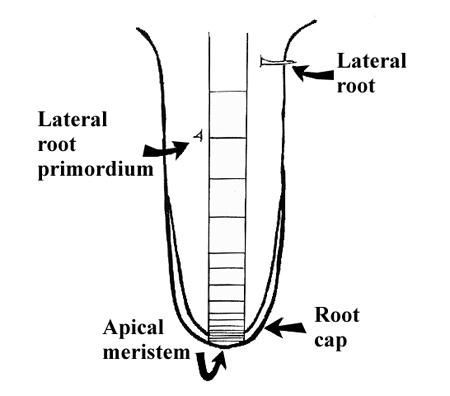
Root Diameter Growth
Many people don't think that roots grow in diameter, but they do! Root diameter growth is similar to growth in the stem with the vascular cambium producing wood (xylem) and bark (phloem). A couple differences between root and shoot diameter growth are (1) cambial growth is much more irregular in roots resulting in roots that are oval or irregular in cross section, and (2) there is greater variation in diameter with age and with horizontal roots compared to vertical roots.
New Root Growth
Roots can also grow new lateral roots that form and branch off the main root. Some cells located in a layer inside the root produce a new root primordium (Figure 11). This new meristem divides and elongates pushing the root out through the parent root. A new lateral root is formed and grows into the soil.
Palms
There are two major points to be made about palm growth: (1) palms only have one terminal growing point, and (2) palms do not grow in diameter as they age. We will talk about how palms grow taller and grow roots and how the one bud influences their form compared to other trees.
Shoot Elongation
The apical meristem lies in a depression at the crown of the stem (Figure 12). Within this meristem is a soft mass of leaves and leaf bases. In this crown there is continuous production of leaf meristems (primordia). There may be up to 50 meristems in the apex. The leaves grow in sequence with one leaf emerging as a spear at a time. The meristem at the base of the leaf causes the leaf to elongate, grow bigger, thicken, and eventually equal the diameter of the palm stem.
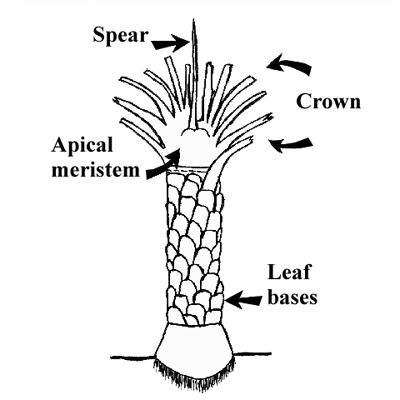
Root Growth
Root growth occurs near the root cap just as in gymnosperms and dicots. However, just like shoot growth of the stem, there is no diameter growth of palm roots. The roots remain the same diameter for long distances (giving the appearance of a spaghetti-like root system) (Figure 13). Descending roots are for anchorage. Most of the horizontal roots are in the top 40 cm of soil and grow out from the palm about 4 m.
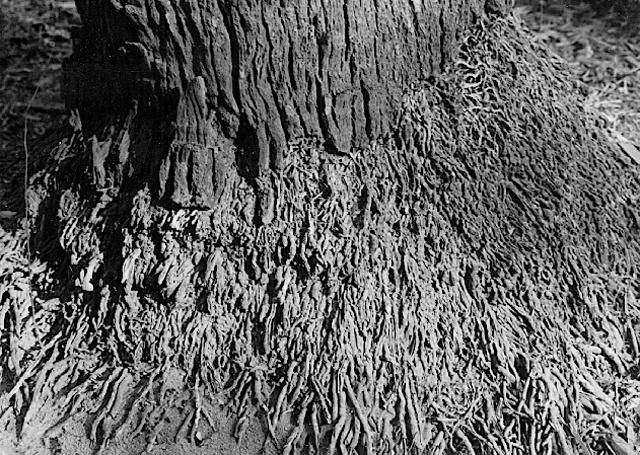
Seasonal Growth, Lifespan, and Aging
Different parts of trees grow at different times of the year, and the pattern, varies by species and climate (Figure 14). In one typical pattern trees begin with shoot growth in the spring, followed by trunk diameter growth and then root growth. However, this growth can occur in any order, and root growth may be year-round or have two growing periods per year. Young trees do more growing in the growing season than older trees. Length of this active growth is determined by temperature, day length, and water.

Tree species have a wide range of lifespans. For example, while peach trees may live only 30 years, oaks may live several hundred years, cypress 1,600 years, and bristle cone pine up to 5,000 years in an undisturbed site in the forest (Kramer and Kozlowski 1979). It may be stressful for several forest tree species when you plant them in the city. The average tree in a downtown lives only 13 years, one tenth the lifespan of a tree at a rural site (Figure 15).
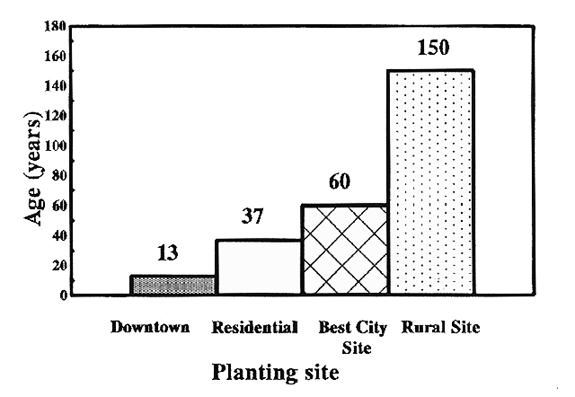
Credit: American Forests 1992
What happens to trees as they age? Some of the likely occurrences are the following: (1) Growth slows down; (2) Trees are more susceptible to diseases and insects; (3) The tops of the trees are more likely to die back; (4) Wounds heal more slowly; (5) There are fewer numbers of leaves relative to the size of the tree; and (6) There is an increased number of dead branches. All of these characteristics can also be seen in urban trees as they begin to die and/or show signs of poor health.
Growth and Tree Form
The apical bud is the bud at the tip of a stem; lateral buds are on the sides of the branches. Apical dominance means that the apical bud at the tip of the stem controls the other buds and inhibits the growth of these buds. Of course most palms only have one apical bud. Therefore, palms usually grow straight with no branching (Figure 16); they are an extreme example of apical dominance. Pines exhibit a little less apical dominance (Figure 17). The main stem is still prominent, but branches formed by lateral buds change the form exhibiting less apical dominance than palms. An oak tree has very little apical dominance with several branches dominating the crown (Figure 18). This illustrates how growth habits can change the form of a tree.

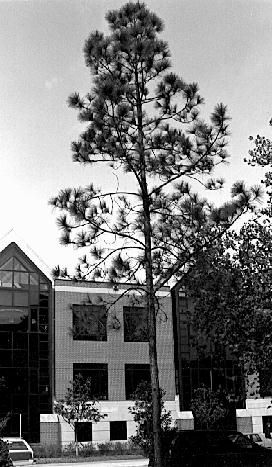
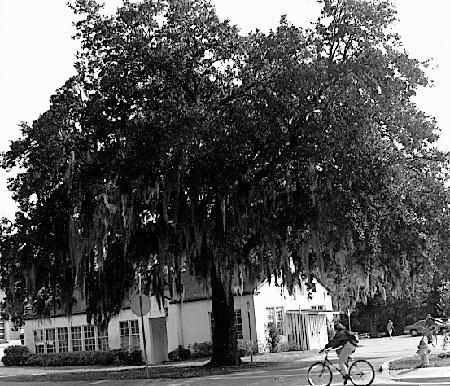
Credit: American Forests, 1992
Some Examples of the Urban Environment's Influencing Growth
Urban trees are subjected to a tremendous amount of stress. Soils are compacted, trees are over- or incorrectly pruned, roots are given very little space to grow, trees are improperly staked, and on and on. A few of the stress-induced practices and environmental conditions are discussed briefly along with how they affect growth.
Pruning: What happens when you prune a tree? If you prune the apical buds, the lateral buds are released and new shoots grow. If you prune older, large diameter stems, two things may happen: (1) Dormant buds that were produced long ago during primary growth can grow into new branches, and (2) New meristems arise and produce new buds and shoots. This growth of new branches is most likely to occur in angiosperms—everyone has seen sprouts from the stump of a freshly cut oak, maple, or elm. Pine trees, however, do not have these dormant buds and will not sprout. Of course, if you remove the apical bud from a palm, it will die—remember most palms only have one bud at the top of the tree.
Staking: How does staking affect growth? Sometimes when small trees are planted, people think that it is necessary to stake them. However, studies have shown that trees that are allowed to sway in the wind are sturdier. Staked trees tend to be less stable and sometimes topple when stakes are removed and trees are exposed to wind (Figure 19). This can be explained by looking at growth differences. When trees blow in the wind, there is a redistribution of the amount and nature of diameter growth on the leeward and windward sides of the tree trunk. "Reaction wood" is formed, and this wood has larger and thicker walled cells than other wood. Hence, when exposed to wind a tree becomes sturdier and can tolerate wind better. For this reason, do not stake young trees unless they absolutely will not stand up without a stake. Remember palms do not have cambial (diameter) growth, so staking palms is okay and often necessary until new roots stabilize the palm in the landscape.
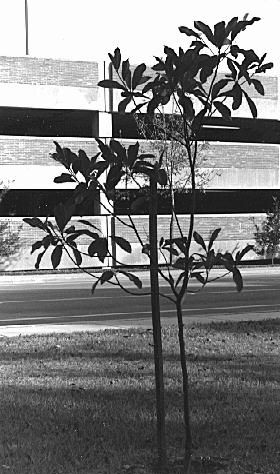
Compacting the soil: Soil conditions in urban plantings are often ignored, but this frequently causes tree health problems. Trees often have limited rooting space and are similar to large potted plants. Soil compaction can occur because of such things as construction equipment, sidewalks and streets, and footsteps. What happens to growth when tree roots are in compacted soil? A study of Monterey pine seedlings showed that trees grown in highly compacted soil had less root volume and weight—roots didn't grow as well in compacted soil (Table 1). This translated into reduced shoot growth—trees were shorter and had less weight when the soil was compacted. This happens in the city too—roots can't grow, water can't permeate into the soil, nutrient uptake is reduced, and the result is poorer tree growth. Of course, the ultimate effect is poor tree health and death. Some ways to avoid compaction are (1) incorporate organic matter into the soil, (2) prevent vehicles from operating beneath the canopy, and (3) when construction traffic must work around trees make sure it is when the soils are dry (wet soils are more easily compacted) or spread a thick layer of coarse mulch beneath the canopy.
Plant Pests
Trees in urban landscapes provide multiple important ecosystem services and functions, (e.g. CO2 uptake, cooling, enhanced aesthetics, etc.). However, urban trees experience increased damage due to arthropod pests relative to trees in more rural settings (Ruapp et al 2010). This damage decreases tree health (Zvereva et al 2010), leading to declines in the services provided by urban trees. Pests can also increase the costs of tree management/maintenance in urban landscapes. Homeowners and urban land managers should be aware of the multiple pests that can harm various tree species in urban landscapes and strategies of integrated pest management to control them.
Conclusions
Trees grow in response to their environment and their genetic make-up. Environmental factors such as high temperature or soil compaction can influence physiological processes such as photosynthesis and in turn impact growth. Meristems are the areas within the tree where growth occurs. Most trees grow in shoot height and diameter and root length and diameter. Palms, however, have only one growing tip and do not grow in diameter. A tree's form is controlled by branch orientation and by the amount of apical dominance. Altering the environment or management practices to decrease stress, and selecting the right tree for the right place will promote growth and longevity.
And, finally, as the tree ages and grows, does the birdhouse move up the tree and out of your reach? No! Why not? Remember a tree only grows in height at the apical meristems at the tips of branches. At the height of the bird-house only trunk diameter growth is occurring.
References
Kramer, P.J., and T.T. Kozlowski. 1979. Physiology of woody plants. New York, NY: Academic Press. 811 pp.
Moll, G. 1992. Trees in the red. Urban Forests. American Forests. Washington, D.C. Feb./Mar. 10.
Raupp, M. J., P. M. Shrewsbury, and D. A. Herms. 2010. "Ecology of herbivorous arthropods in urban landscapes." Annual Review of Entomology 55: 19–38.
Sands, R., and G.D. Bowen. 1978. "Compaction of sandy soils in radiata pine forests. II. Effects of compaction on root configuration and growth of radiata pine seedlings." Aust. For. Res. 8:163-170.
Zvereva, E. L., V. Lanta, and M. V. Kozlov. 2010. "Effects of sap-feeding insect herbivores on growth and reproduction of woody plants: a meta-analysis of experimental studies." Oecologia 163: 949–960.
For More Reading about Tree Growth
Bell, A.D. 1991. Plant Form: An Illustrated Guide to Flowering Plant Morphology. New York, NY: Oxford Univ. Press.
Corner, E.J.H. 1966. The Natural History of Palms. Berkeley, CA: Univ. Cal. Press. Berkeley. 393 pp.
Fahn, A. 1991. Plant Anatomy. Fourth edition. Oxford: Pergamon Press. 588 pp.
Harltey, C.W.S. 1977. The Oil Palm (Elaeis guineensis Jacq.). Second edition. London, UK: Longman. 806 pp.
Harris, R.W. 1992. Integrated Management of Landscape Trees, Shrubs, and Vines. 2nd edition. New Jersey: Prentice-Hall. 674 pp.
Kozlowski, T.T. 1971. Growth and Development of Trees. Vol. I. Academic Press. New York. 443 pp.
Kozlowski, T.T., P.J. Kramer and S.G. Pallardy. 1991. The Physiological Ecology of Woody Plants. New York: Academic Press. 657 pp.
Laetsch, W.M. 1979. Plants - Basic Concepts in Botany. Boston, MA: Little, Brown and Company. 510 pp.
Mosbrugger, V. 1990. The Tree Habit in Land Plants. In: S. Bhattacharji, G.M. Friedman, H.J. Neugebauer, and A. Seilacher (eds.). Lecture Notes in Earth Sciences , Vol. 28. Springer-Verlag. Berlin. 161 pp.
Uhl, N.W. and J. Dransfield. 1987. Genera Palmarum. A Classification of Palms Based on the Work of Harold E. Moore, Jr. Lawrence, KS: Allen Press, 610 pp.
Wilson, B.F. The Growing Tree. 1984. Amherst, MS: Univ. Mass. Press. 138 pp.
Acknowledgments
We are very grateful for the constructive and thorough reviews of this publication made by Ed Gilman, Bill Hubbard, Bira Malavasi, and Tim White. Additional thanks go to Bira Malavasi for the informative drawings of tree growth used in this publication.


